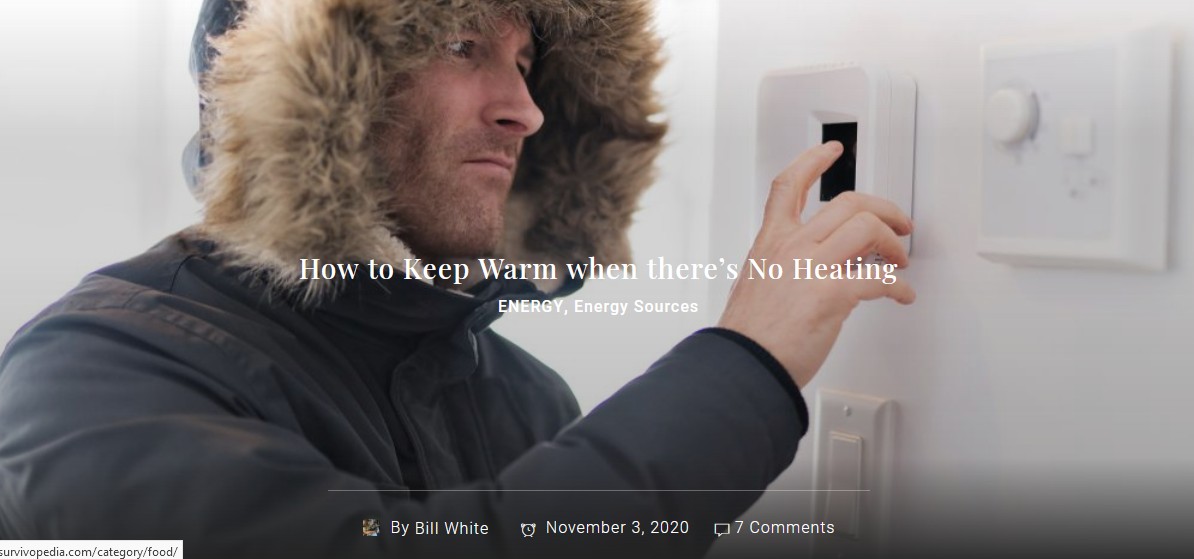☝ Being Prepared from the Field of Master Mind Survival (MMSUR) 😱
Shared from the research of: Joseph Mercado 👨
Article Author: Bill White – Survivopedia
To: Survivalist 📡
Blog Post #1122 📌
Re: Staying Warm When There Is No Heat
Date and Time: Monday, February 8, 2021 at 7:02 p.m. ⏰
Dear Survivalist,
Hey! It’s cold out there!
This always seems to be a shocking revelation when that first chill of autumn comes to call.
We understand it’s coming on an intellectual basis, but when it actually hits, we always seem to be surprised.
We wake up one morning to find a cold house because we forgot to turn the heat on and all our winter coats are hidden away, where they’re hard to get to.
I guess we could call this one more example of how far modern society is from the basics of survival.
We’re so far removed from the necessity of making sure we can survive through the winter, that for most of us, our only preparation for cold times is getting ready for the football season.
If the heat actually went out for an extended period of time, most of us wouldn’t know what to do.
This smart device will help you slash an excess of 70% off your power bill overnight…
Yesterday I received a reminder of this, as a high school friend up north had re-posted a request for help from a single mother, whose power was out.
It was 40 degrees in her house and she was asking if there was a shelter available she could take her kids to.
But the sad thing was, she hadn’t even thought about dressing them warmer in the meantime, so they could better handle the cold.
While this might be a rather extreme example of not knowing how to handle such common things as cold weather, it truly illustrates how far we are from the basics of survival as a society.
While those of us who consider ourselves preppers are in much better shape with our survival knowledge, there are still things our ancestors did, for which many of us are unaware and unprepared.
Even the way we build our homes is not conducive to a life without all the luxuries that modern society has to offer.
So, what would you do if the power went out and stayed out this winter? How would you stay warm?
Off-Grid Heating:
I don’t want to belabor the point, because that’s not really what this article is about, but we all need some alternative means of heating our homes, without electricity.
Whether that’s a wood-burning stove or kerosene heaters, we’ve got to have something on-hand and in place to heat at least part of our homes. That’s just about as basic a part of prepping as stockpiling food is.
But what saddens me is how few preppers actually have enough fuel to get through the winter.
I’ve seen many a prepper home where they installed a wood-burning stove, but only have a face cord of firewood to burn in it.
According to people who regularly heat their homes with wood, it takes four to six full cords of hardwood firewood to make it through winter.
Regardless of what off-grid heating system to opt for, make sure you have enough fuel to make it through the hard times; whatever those hard times might be.
Can You Restock Your Fuel?
Another place where preppers tend to fall short is in ensuring that they have a means to restock their fuel, once they’ve used it up.
Even if you do have enough firewood to get you through this winter, what about next?
In a long-term survival situation, you might need to harvest enough firewood or other fuel to make it through each winter.
This will be complicated by other people trying to do the same thing.
The people who aren’t prepared will be tearing apart abandoned homes, cutting down neighborhood trees, and everything else they can do, just to make it through the first winter.
It’s highly unlikely that there will be any firewood available in town, even in the suburbs, to get any of us through a second winter.
You’re going to need some means of harvesting firewood away from town and getting it back home.
If we assume that there won’t be any gasoline and we can’t use our cars and trucks to move that wood, it’s going to be extremely hard to harvest that wood, even if it’s only a few miles away.
The other option is to come up with an alternative fuel that can be burned in your wood-burning stove.
People have made fireplace logs out of newspaper for years and some enterprising preppers have found ways of adding additional material, such as sawdust and leaves, to that mix.
While there won’t be any newspapers being delivered in a post-disaster world, there will be lots of paper that can be scavenged, allowing you to come up with your own brand of off-grid imitation firewood.
But I’d start now so that you have the recipe and mixing equipment ready.
But again, that’s not really the subject of this article.
Expanding Your Ability to Keep Warm:
While our ancestors had fireplaces or wood-burning stoves to warm their homes, that wasn’t all they did.
Most homes only had one fireplace to produce heat. If they had a fireplace and a wood stove in the kitchen, that family was very well off indeed.
Yet they managed to find ways of keeping themselves warm through the winter, even though their homes weren’t thermostatically controlled to a nice comfortable 75°F.
The same methods would probably work for us, even though we might need some modifications to use them in our modern homes.
What’s even better, is that we can use them now, reducing our energy costs, without having to wait for a power outage to come.
Only Use Part of the Home:
Homes today are much more complex than they were 100 years ago.
What we consider to be an average suburban home would probably have been thought of as a mansion, or nearly so, with the exception of the fancy woodwork that mansions had back then.
But as far as size and the number of rooms we have, they would definitely be impressed.
But all those rooms are a problem.
By and large, any fireplace or wood-burning stove is a one-room apparatus, which can only heat one room of your home.
The heat doesn’t travel well from there to any adjacent rooms, simply because of the small openings that are our doorways.
Fortunately, even if has happened accidentally, newer homes are going with more of an “open living” concept, where the living room, dining room, kitchen, and family room are all open to one another.
This makes it possible for heat to radiate around the entire living area of the home, warming it.
That doesn’t help the bedrooms, but if you have a newer home with this open living sort of design, you can count on having at least some heat throughout the living area of your home.
So what about the rest of the home? Close it off and don’t use it.
While all those rooms are nice to have, you can all sleep on the living room floor in a pinch.
If it’s actually that cold, then don’t even try to warm the bedrooms; take advantage of the warmer part of the house.
Heat by Convection:
Another thing their home designs did much more effectively than ours was to heat by convection.
Yes, our ancestors were way ahead of us on that one, even though their homes were much smaller and simpler than ours.
What I’m specifically referring to here is having a sleeping loft, open to the room below.
Since heat rises, that would be the warmest part of any home, regardless of how well the fireplace worked and how cold it got outside.
Usually, the kids slept in that loft, although in some families, everyone did.
The open home concept I was talking about a moment ago can help here if you have a two-story home that’s designed for it. cathedral ceilings and balconies allow the heat from the fireplace to rise, warming the second-story room, assuming that people remember to leave the doors open.
But what can you do, if you don’t have an open second floor like that?
One thing is to open up the stairway, rather than having one that’s closed off. An open stairway will allow more air movement between the floors, getting some of that heat upstairs. Just make sure you’re not removing a load-bearing wall before you start cutting things out.
Another good way to get heat upstairs is to cut vents between the first floor of the home and the second.
A simple hole through the upstairs floor, covered by a grating, will allow heat to rise, without disturbing the use of the home.
If the home has a partial second floor, with dormers, it’s quite possible that there is space under the eaves, which is over the first floor and not being used by the second floor.
In that case, that area can be easily turned into a vent, cutting vents into the floor and the wall of the upstairs room.
Just be sure to insulate the rafters, which probably aren’t already insulated.
Heat Yourself Twice:
There’s a reason why falling trees and cutting wood was a wintertime activity.
Not only were farmers too busy to cut wood during crop times, but cutting wood in the wintertime served to warm them twice, once while cutting the wood and the second time when they were burning it.
Our modern sedentary lifestyle doesn’t lend itself to keeping ourselves warm.
We’d all be a lot better off if we were a bit more active.
That’s especially true during cold weather when many people struggle to feel warm.
Save those heavy physical projects for the winter and do them then, when you won’t procrastinating about them because of how hot it is.
Wear Warm Clothing:
As I said about the woman in the introduction, this one is so obvious that it shouldn’t have to be mentioned; but I’ll mention it anyway.
The truth is, we’re all so used to central heating keeping us warm, that we don’t bother with warm clothing.
I’ve got lots of nice sweaters that I don’t use, even in the wintertime, because they’re just too darn hot.
While they might feel comfortable outdoors, they sure aren’t when I’m home. So they mostly sit in the dresser, waiting for colder times.
A number of years ago, I lived much farther north, in a home where my office was in an unfinished attic.
In the summertime I got a fairly good breeze through the attic, making it bearable and in the wintertime, I used those sweaters.
Although I had a kerosene heater in the office, I usually only used it to take off the morning chill; then once the chill was gone, I turned it off.
I was comfortable working in that 50° attic, as long as I had a thick sweater on.
Pile on the Blankets and Share Body Heat:
Speaking of those years living up north, we had a comforter on our bed that seemed to be four inches thick.
Actually, it wasn’t. It was a normal comforter, to which had been added two more layers of thick quilt batting and a layer of fake fur.
While that sounds a bit strange, it sure was nice on those cold winter nights.
Believe it or not, bed coverings aren’t just for decoration; they’re to keep us warm. If yours aren’t then perhaps you need to pile more on. I never saw a law limiting the number of blankets and comforters that can be put on one bed.
Families would do that in the winter and still do in Mexico and other countries where central heating isn’t all that common.
The other thing they did was to share beds.
Now I realize that might be a problem in our current culture, but back then all the kids would usually sleep together so that they could keep each other warm.
Mom and dad didn’t sleep on opposite sides of a king-size bed; they cuddled together all night long. Not only did that help keep them warm, but it was also good for their relationship.
Use a Bed Warmer:
The old bed warmer was one of mankind’s great inventions.
You’ve probably seen one; a copper frying pan with a hinged lid and a long handle.
People would use it to warm up the sheets, before sliding between them, making the bed a whole lot more comfortable.
Contrary to popular belief, they didn’t put coals from the fire in the bed warmer.
Had they done so, their nice white sheets would have turned black. Rather, they warmed stones in the coals of the fire and then put those coals in the bed warmer, often wrapped in a rag.
If you could find a bed warmer today, you probably wouldn’t want to use it, as it would be an antique.
But that’s not to say you can’t make one yourself. All you need is a metal frying pan with a lid; aluminum or copper would be best.
Attach a hinge, so that the lid can be opened, without becoming separated from the pan and change the existing handle for a longer one.
Most frying panhandles are attached with only one screw, so it really isn’t all that hard to change the handle.
Use a Heat Stone:
Speaking of stones, the idea of using stones as a means of portable heat was commonplace in olden times.
Specifically, they would use soapstone, warmed in the coals of the fire, and wrapped in a cloth carrier.
This could be taken in the wagon, placed under the seat, providing heat while going to town.
Between the warm stone under the seat and a blanket across their laps, people were much warmer.
Those sitting in the back of the wagon would sit with their backs to the seat so that they could get the advantage of that heat as well.
The soapstone didn’t just stay in the wagon either.
When people went to church, they’d bring it in with them, to warm their family pew.
Have you ever seen pictures of those old churches whit boxed in pews?
That wasn’t for snobbery; that was to help keep the heat in from their soapstone.
If it worked for them, it would work for us as well. I never tried it, but I imagine if I had taken heated soapstone up to my uninsulated and unheated attic office all those years ago, I wouldn’t have needed that kerosene heater.
All I would have had to do is put the stone in the well of my desk, and a blanket over my knees.
Between that and my sweater, I would have been fine.
About the Author – Bill White:
Bill White is the author of Conquering the Coming Collapse, and a former Army officer, manufacturing engineer and business manager. More recently, he left the business world to work as a cross-cultural missionary on the Mexico border. Bill has been a survivalist since the 1970s, when the nation was in the latter days of the Cold War. He had determined to head into the Colorado Rockies, should Washington ever decide to push the button. While those days have passed, the knowledge Bill gained during that time hasn’t. He now works to educate others on the risks that exist in our society and how to prepare to meet them. You can send Bill a message at editor [at] survivopedia.com.
Content Source: Survivopedia.com

 Email Us a Message
Email Us a Message 

Please send us a personal message below and we will serve you momentarily.
We appreciate you visiting the MMU Global Research Directory
For more blog posts, videos, articles, and to generate more knowledge, please feel free and…







 Fly Over to the MMU Facebook Page with Hoot
Fly Over to the MMU Facebook Page with Hoot 
 Visit the MMA Facebook Group Today
Visit the MMA Facebook Group Today 
 Claim Your 32GB I-CHIP Think Drive Here for Only $67
Claim Your 32GB I-CHIP Think Drive Here for Only $67 